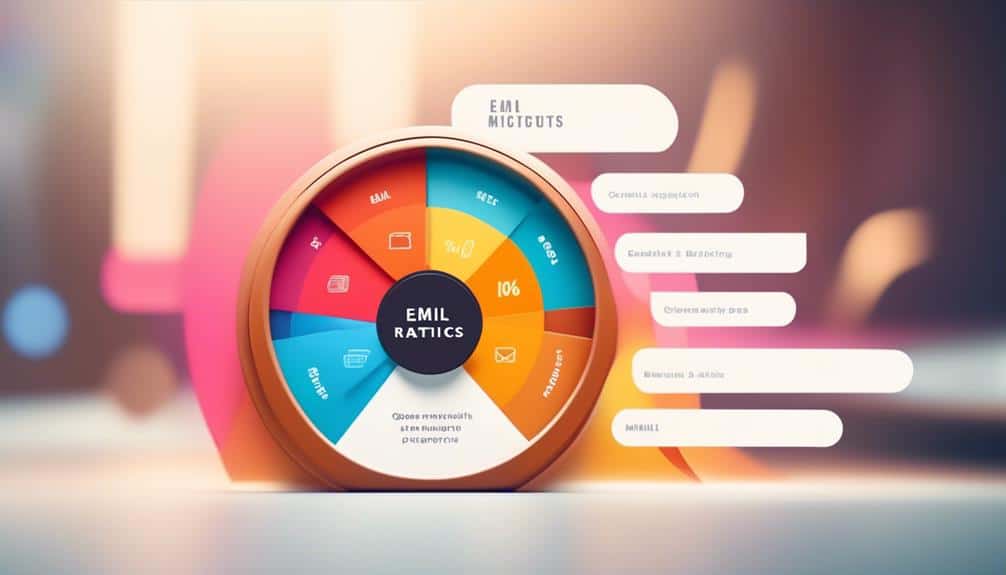Maximize Your Email Impact With the Latest in Analytics Technology
In a world where email overload is a constant struggle, it's crucial to find ways to stand out from the crowd and make a lasting impact. But how can you accomplish this without spending countless hours analyzing data and deciphering complex metrics?
The answer lies in the latest advancements in analytics technology. By harnessing the power of these cutting-edge tools, you can unlock a wealth of insights that will help you maximize the effectiveness of your email campaigns.
But what exactly do these analytics technologies have to offer? And how can they help you take your email game to the next level?
Key Takeaways
- Understanding email metrics is essential for optimizing email campaigns and maximizing impact.
- Email segmentation and A/B testing can help tailor content and improve engagement and conversion rates.
- Personalizing email campaigns can significantly increase open, click-through, and conversion rates.
- Testing and analyzing email performance is crucial for making data-driven decisions and improving results.
Understanding Email Metrics

Understanding email metrics is essential for optimizing email campaigns and maximizing their impact. By measuring email success through analytics, you gain valuable insights into the effectiveness of your email marketing efforts.
One crucial aspect of email metrics is email segmentation, which involves dividing your email list into specific groups based on various criteria such as demographics, interests, or purchasing behavior. By segmenting your email list, you can tailor your messages to each group's specific needs and preferences, resulting in higher engagement and conversion rates.
Measuring email success goes beyond simply tracking open and click-through rates. It involves analyzing key metrics such as conversion rate, bounce rate, and unsubscribe rate. These metrics provide a deeper understanding of how your subscribers are responding to your emails and allow you to make data-driven decisions to improve your campaigns.
For example, a high bounce rate may indicate issues with your email list quality or deliverability, while a low conversion rate may suggest that your content or call-to-action needs improvement.
Tracking Email Engagement
To effectively measure email success and optimize your campaigns, it's crucial to track email engagement metrics that provide valuable insights into subscriber behavior. Tracking email engagement allows you to understand how recipients interact with your emails, helping you make data-driven decisions to improve deliverability and measure conversion.
One important metric to track is the open rate, which tells you how many recipients open your emails. A low open rate may indicate issues with subject lines or sender reputation, while a high open rate suggests strong engagement from your subscribers.
Click-through rate (CTR) is another critical metric to monitor. It measures the number of recipients who click on links within your emails. A high CTR indicates that your content is compelling and relevant, while a low CTR may signal the need for improvement.
Engagement metrics like time spent reading emails and the number of emails marked as spam can also provide valuable insights. By analyzing this data, you can tailor your content to increase engagement and avoid spam filters.
Optimizing Email Content

Optimize your email content by analyzing engagement metrics and tailoring your messaging to increase subscriber interaction. By understanding how your audience interacts with your emails, you can create more effective and personalized content that resonates with them. Two key strategies for optimizing email content are email segmentation and A/B testing.
Email segmentation involves dividing your email list into smaller, more targeted groups based on specific criteria such as demographics, purchasing behavior, or engagement level. This allows you to send more relevant content to each segment, increasing the chances of engagement and conversions. For example, you can segment your list based on previous purchases and send tailored product recommendations to each segment.
A/B testing, on the other hand, involves creating two versions of an email and testing them with a small portion of your audience to see which performs better. This allows you to experiment with different subject lines, calls to action, or content formats to determine what resonates best with your subscribers. By analyzing the results, you can optimize your email content to drive higher engagement and conversion rates.
Table: Strategies for Optimizing Email Content
| Strategy | Description |
|---|---|
| Email Segmentation | Divide your email list into smaller, targeted groups based on specific criteria |
| A/B Testing | Test different versions of your email to determine what resonates best with your subscribers |
Personalizing Email Campaigns
By using advanced analytics technology, you can personalize your email campaigns to deliver highly targeted and relevant content to each individual subscriber. This level of personalization allows you to improve segmentation and enhance the customer experience.
Here are three key benefits of personalizing your email campaigns:
- Increased engagement: Personalized emails have higher open and click-through rates compared to generic emails. When subscribers receive content that's tailored to their specific interests and needs, they're more likely to engage with your emails and take the desired action.
- Improved conversion rates: Personalization can significantly impact conversion rates. By delivering content that resonates with each subscriber, you can increase the likelihood of them making a purchase or taking another desired action. This targeted approach eliminates irrelevant content and ensures that subscribers receive messages that are relevant to their needs.
- Enhanced brand loyalty: Personalization creates a sense of individual attention and care, which can foster a stronger connection between your brand and subscribers. When customers feel valued and understood, they're more likely to remain loyal to your brand and continue engaging with your emails and products.
Personalizing your email campaigns not only improves segmentation and enhances the customer experience but also drives higher engagement, conversion rates, and brand loyalty. Take advantage of advanced analytics technology to deliver personalized content that resonates with each subscriber, and watch your email impact soar.
Testing and Analyzing Email Performance

Testing and analyzing email performance is crucial for maximizing the impact of your email campaigns. By using email segmentation and A/B testing, you can gain valuable insights into what works best for your audience and optimize your email marketing strategy accordingly.
Email segmentation allows you to divide your subscriber list into smaller, more targeted groups based on factors such as demographics, interests, or past behavior. This enables you to send personalized and relevant content to each segment, increasing engagement and conversion rates. A/B testing, on the other hand, involves sending two versions of an email to a small sample of your audience and measuring their response to determine which version performs better. This allows you to make data-driven decisions and refine your email content, subject lines, or calls-to-action for maximum impact.
To illustrate the importance of testing and analyzing email performance, here is a table showcasing the results of an A/B test conducted by a fictional company:
| Email Version | Open Rate | Click-through Rate | Conversion Rate |
|---|---|---|---|
| Version A | 20% | 5% | 2% |
| Version B | 25% | 7% | 3% |
As you can see, Version B outperformed Version A in all key metrics. By analyzing these results, the company can conclude that Version B resonates better with their audience and should be used for future email campaigns.
Frequently Asked Questions
How Can I Ensure That My Email Reaches the Recipient's Inbox Instead of the Spam Folder?
To ensure your email reaches the recipient's inbox instead of the spam folder, focus on email deliverability. Implement best practices like avoiding spam trigger words and regularly checking your sender reputation.
What Are Some Effective Strategies to Increase Email Open Rates?
To increase email open rates, personalize your emails to make them more engaging and relevant. Use A/B testing to experiment with different subject lines and content formats to identify what resonates best with your audience.
Are There Any Industry Benchmarks for Email Click-Through Rates That I Should Aim For?
You should aim for industry benchmarks in email click-through rates to maximize your email impact. Use email personalization and segmentation to increase engagement and drive more clicks.
What Are Some Best Practices for Creating Compelling Subject Lines That Grab the Recipient's Attention?
Crafting attention-grabbing subject lines is crucial for email impact. Use concise, data-driven language to create engaging content. Aim for subject lines that pique recipient's curiosity, use personalization, and evoke a sense of urgency.
How Can I Measure the Overall Success of My Email Campaign in Terms of Revenue Generated or Conversions?
To measure the overall success of your email campaign in terms of revenue or conversions, use analytics technology. It helps optimize email deliverability and provides data-driven insights, allowing you to make informed decisions for maximum impact.
Conclusion
By leveraging the latest analytics technology, you can maximize the impact of your email campaigns. Understanding email metrics allows you to track engagement and optimize your content for better results.
Personalizing your campaigns based on data-driven insights can significantly improve your email performance. Additionally, testing and analyzing your email campaigns will help you make data-backed decisions to continuously improve your email marketing strategy.
Stay ahead of the competition by harnessing the power of analytics in your email marketing efforts.








